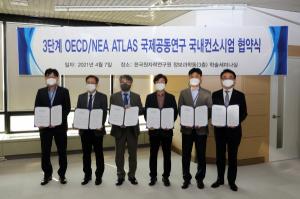3rd OECD/NEA ATLAS study from this year to 2024
Twenty institutions from 12 countries participated… Experimenting under the same conditions as the actual nuclear power plant
[에너지신문] Domestic institutions and companies are launching an international joint research on ATLAS to verify the safety of nuclear power plants. This research is supervised by the Atomic Energy Agency (NEA) under the Organization for Economic Cooperation and Development (OECD).
Six institutions, including KHNP, Atomic Energy Research Institute, Nuclear Safety Technology Institute, Korea Electric Power Technology, KEPCO, and Doosan Heavy Industries & Construction, decided to join forces for the 3rd OECD/NEA ATLAS international joint research at the Atomic Energy Research Institute on the 7th. A domestic consortium agreement was signed.

Following the successful completion of the 1st (2014~2017) and 2nd (2017~2020) of the OECD/NEA ATLAS International Joint Research, this 3rd International Joint Research will be conducted for a total of 4 years from this year to 2024. The tertiary research will be conducted by 20 organizations in 12 countries, including the Czech Republic, Belgium, Spain, Switzerland, Germany, UAE, and China, as well as traditional nuclear power plants such as the United States, France, and Russia.
The OECD/NEA ATLAS international joint research is to conduct an empirical test to confirm the safety of nuclear power plants using ATLAS (Advanced Thermal-Hydraulic Test Loop for Accident Simulation), a pressurized hard water reactor thermal-hydraulic comprehensive effect test device built by the Atomic Energy Research Institute.
ATLAS is a new Korean light water reactor, APR1400, reduced to 1 in 288 in volume. All accidents, breakdowns, and operating conditions that may occur at a nuclear power plant can be tested at the same pressure and temperature as the actual nuclear power plant. In addition, since electric heating rods are used instead of uranium fuel, various accidents can be implemented without fear of radiation leakage.

In particular, in this third international joint study, KHNP’s export-type nuclear power plant APR1000, which will participate in the Czech new nuclear power plant project, is planning to conduct an empirical experiment on the Passive Auxiliary Feedwater System first adopted.
The APR1000’s passive auxiliary water supply system was developed by KHNP, and it is the latest system that can safely cool nuclear power plants even in situations where external power is lost, such as in Fukushima, as it is driven by natural forces such as gravity. As the passive auxiliary water supply system demonstration experiment is adopted as an international joint research experiment item, it is expected that the excellence of the new safety concept will be confirmed.
In addition, KHNP is expected to be able to internationally verify the excellence of the domestic nuclear power plant safety analysis program by using the domestic nuclear power plant safety analysis program (SPACE) developed with Korea’s own technology to analyze the data for this demonstration.
Copyright © The Energy Newspaper Unauthorized reproduction and redistribution prohibited
